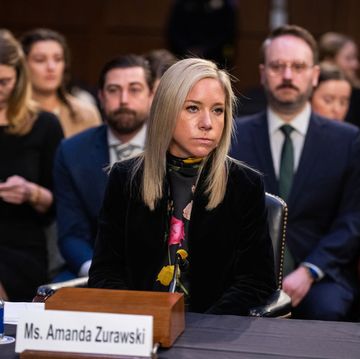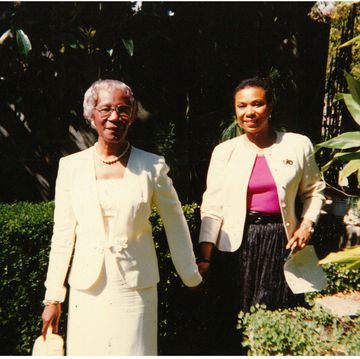Valentine’s Day is as good a time as any to reflect on the hideous norms of our dating culture. The latest example: Kanesville Elementary School in West Haven, Utah, where little girls were told not to say no to boys who ask them to dance.
The rule was brought to national attention by Natalie Richard, whose daughter is in sixth grade at Kanesville. This weekend, Richard told local news station KSTU that her daughter came home complaining she wasn’t allowed to refuse the boys in her class who wanted to dance with her at an upcoming school event. Richard initially thought her daughter had simply misunderstood the rule, but she said her daughter’s teacher confirmed her account: "The teacher said she can’t [turn them down]. She has to say yes. She has to accept, and I said, 'Excuse me?'" Richard said the principal shrugged off her complaint, reportedly telling her that “they’ve had this dance set up this way for a long time and they’ve never had any concerns before.”
Lane Findlay, the Weber School District’s community relations specialist, told KSTU the rule is intended to teach students inclusion: “We want to promote kindness, and so we want you to say yes when someone asks you to dance.” Richards, however, is not convinced. The rule, she said, "sends a bad message to boys that girls can’t say no."
In a statement to ELLE.com, Findlay clarifies that in advance of the dance, each student fills out a "dance card" with the names of classmates they want to dance with. And while Findlay acknowledges that “students [are] told by their teacher that if a classmate asks to be on their card, they should be polite and respectful, and agree to dance with that person,” he adds that the policy “applies to all students regardless of gender.” (Still, due to the concerns that have been raised, district officials have said they will re-examine their “procedures around school dances” and “have advised our schools to eliminate any sort of language in the instructions surrounding these dances that would suggest a student must dance with another student.”) When asked whether the rule applied to students who selected a partner of the same sex, Findlay said that “students are given the choice who they wish to dance with so I guess they could choose someone of the same gender.”
Whether or not the schools do implement new policies, the initial rule distills some of our culture’s worst tendencies around issues of consent and what counts as “romance” into one troublesome commandment. Every time a girl is told to suppress her own feelings and say yes to a boy she doesn’t like, she’s getting the message that the boy’s desire is more important than hers, and that to reject him would make her a bad or mean person. (And for that matter, boys shouldn't be made to feel that it's wrong to refuse someone else's attentions either.) Nor does the rule seem likely to accomplish its intended purpose. “Inclusion” is learned when children are taught not to bully each other and to see the value of diversity, not when we encourage kids to badger each other into quasi-romantic exchanges they don’t want to be having.
Incidents like this one have become a central issue for consent advocates, who increasingly argue that kids need to be taught about physical and social boundaries, including their own right to say no to unwanted touch, very early in life. The link between an unhappy dance and sexual assault is not one most of us would make, but the fact is when we teach children that they can be touched without their permission or suggest that it's "nice" to let someone have something they don't want to give—even if it's small, like a hug or a dance—we inadvertently show them that they don't have the ultimate decision on what is done to them. And that lesson lays a foundation for toxic sexual and romantic attitudes later on.
To counteract that, some advocates argue that children as young as one year old can begin to learn about consent. These lessons aren't about sex, but about good boundaries and communication. One list of parenting action items, compiled by Joanna Schroeder, Julie Gillis, Alyssa Royse, and Jamie Utt, includes seemingly obvious lessons for pre-school students such as “[never] force a child to hug, touch or kiss anybody, for any reason” or “[teach] your kids that ‘no’ and ‘stop’ are important words and should be honored.” But it also encourages parents to model consent through simple things like letting kids pick out their own clothes (within reason) or asking for permission to touch them during bath time. (This includes suggested dialogue like, “Can I wash your back now? How about your feet? How about your bottom?” If the child refuses, the parent must honor the request and ask them to wash themselves.)
The idea of teaching consent to elementary school students can feel overzealous or maybe even inappropriate. But it’s vital. Children are vulnerable to sexual assault. The Center for Disease Control and Prevention has found that 42.2 percent of female rape victims were assaulted under the age of 18, and 28 percent of male victims were first raped at age 10 or younger. The CDC also finds that, by high school, one in 10 students has experienced physical violence from a partner. According to 2013 research from the Urban Institute, by college, one in six girls has been sexually abused in a dating relationship.
“I think that changing culture takes a heck of a lot of time, and it's easier to start by introducing concepts like consent very early,” Julie Gillis, who helped compile the parental action items list, tells ELLE.com. “It doesn't have to be described as sexual, just that we have the right to keep our bodies to ourselves...and that relationships are not, or should not be, one sided….The earlier we teach those skills, the better the outcome for everyone.”
When children grow up hearing that their bodies are theirs to control and knowing that their boundaries are firm and will be respected, they’re likely less primed to believe “loving” relationship can include hitting or sexual coercion. And it's not just girls who benefit. Boys who understand that it’s not okay to guilt-trip someone into a kiss or hug are not only less likely to be predators, they’re less likely to stay in relationships where they’re abused.
We teach one gender to undervalue their own needs, and teach the other gender to overvalue their own desires. Any opportunity we have to disrupt those old narratives is a good one—even if it’s as simple as letting a little girl know that, if she doesn’t like her partner, she doesn’t have to dance.













